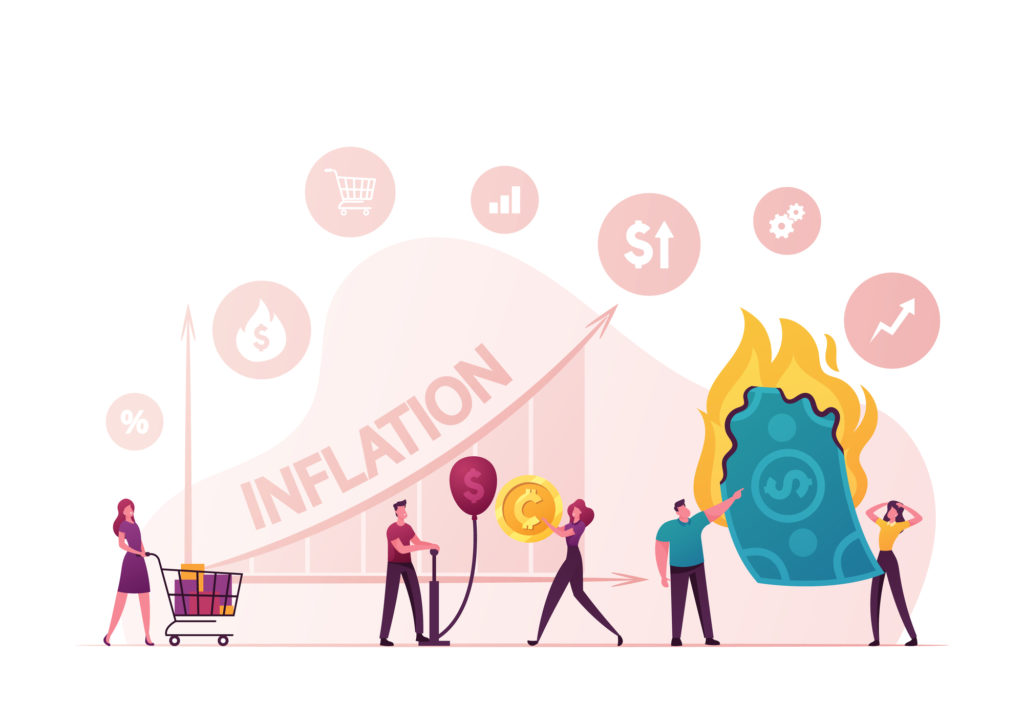 For the past decade, inflation has been very modest (only 1.23% in 2020, 1.81% in 2019, and 2.44% in 2018). But things are changing. In June, the Consumer Price Index (CPI) for All Urban Consumers rose 0.9% for the month, producing an inflation rate over the last 12 months of 5.4%. Some may remember double-digit inflation, which peaked in 1980 at 13.55%. While experts aren’t predicting these high rates, nonetheless inflation is now a factor with which to contend in your business. In fact, two-thirds of small business owners fear that inflation will hurt their recovery.
For the past decade, inflation has been very modest (only 1.23% in 2020, 1.81% in 2019, and 2.44% in 2018). But things are changing. In June, the Consumer Price Index (CPI) for All Urban Consumers rose 0.9% for the month, producing an inflation rate over the last 12 months of 5.4%. Some may remember double-digit inflation, which peaked in 1980 at 13.55%. While experts aren’t predicting these high rates, nonetheless inflation is now a factor with which to contend in your business. In fact, two-thirds of small business owners fear that inflation will hurt their recovery.
Here are 5 areas to examine.
1. Higher interest expenses
If you need to borrow money, you’re going to pay more. Interest rates charged by banks, credit card companies, and other lenders don’t move in lockstep with changes in the rate of inflation, but they do adjust somewhat. Expect that interest rates on lines of credit, credit cards, and new loans will be higher than what you’ve become used to in recent years.
What to do:
Because borrowing will cost more, look for other ways to get the money you need for business growth. Consider stockpiling revenue to the extent possible that may be used for future activities. And save money down the road by paying off existing loans.
2. Higher wages and benefits packages
Inflation has a way of pushing up wages and benefits (employees need more money just to stay even with their personal expenses).
What to do:
Review your current wage and benefits package and see whether adjustments need to be made. Revisit your budget for these items, factoring in the additional cost of payroll taxes on compensation and taxable benefits.
3. Higher costs for inventory, materials, and supplies
It’s no secret that the cost of many things you need for your business, such as materials for building contractors and gasoline for long-haul truckers, is higher and having an impact on your business profits. Of course, prices for things rise and fall. The cost of lumber soared, peaking in May 2021, but is slowly declining. Still, with inflation, expect that the cost of many things you use in your business will continue to increase.
What to do:
Review your anticipated purchasing needs for the balance of the year. Explore suppliers that may be able to offer better pricing.
4. Higher taxes
There are various proposals to increase taxes for businesses and high-income individuals (many small business owners fall into this category because of having to report income passed through to them from their businesses). It’s not clear now what and when new tax rules will apply. Nonetheless, inflation may mean higher income, that translates into higher taxes.
What to do:
Continually monitor your tax picture so you can adjust your estimated tax payments for the year. The second installment of estimated taxes for 2021 is due on September 15, 2021.
5. Need to raise prices
One of the things that many business owners hesitate to do for fear of losing customers is raising prices. But prices must be increased to maintain your profit margin if it’s costing you more to run your business (see items 1-4). The Federal Reserve reported (click on “Current Release”) in July 2021 that 51% of firms had to increase prices due to supply chain issues.
What to do:
Apply smart pricing strategies. For example, find out what competitors are doing with their prices. Decide whether to make a single price adjustment for spread increases, restrict price increases to new customers, or merely impose an inflation surcharge that may be lifted at some point.
Final thought
President Ronald Reagan said: “Inflation is as violent as a mugger, as frightening as an armed robber and as deadly as a hit man.”
While inflation isn’t as virulent as it was when he took office 1981 (remember inflation peaked in 1980), it’s still something to contend with now. Given continued government spending and other current economic factors, it’s not likely that the current high rate of inflation will dissipate anytime soon.


